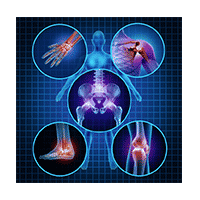 Reflex Sympathetic Dystrophy (RSD) Syndrome is a chronic pain condition that occurs most commonly in an arm or leg. Doctors aren’t certain of the exact cause but believe it is the result of a problem in your sympathetic nervous system. This part of your nervous system controls blood flow, heart rate, and blood pressure.
Reflex Sympathetic Dystrophy (RSD) Syndrome is a chronic pain condition that occurs most commonly in an arm or leg. Doctors aren’t certain of the exact cause but believe it is the result of a problem in your sympathetic nervous system. This part of your nervous system controls blood flow, heart rate, and blood pressure.
The specialized providers at Commonwealth Spine & Pain Management share some information about Reflex Sympathetic Dystrophy to help you in your journey to living pain-free.
Possible Causes of Reflex Sympathetic Dystrophy
In rare cases, the sympathetic nervous system malfunctions after events such as
- Fractured bones
- Surgery
- Sprains or strains
- Cuts
- Bruises
- Stroke
- Heart Attack
- Intense stress
Some patients experience RSD without any previous medical condition.
Medical Tests Helpful In Diagnosing RSD
There isn’t a specific medical test for RSD, so your doctor will rely heavily on a detailed medical history. The tests that are available for help in diagnosis are:
- Bone scan. This can show if you have a problem with bone loss or adequate blood flow.
- Ultrasound or Magnetic Resonance Imaging (MRI). These can reveal nerve damage.
- Sweat test. This can reveal abnormal sweat gland function seen in RSD.
- Thermography test. A difference in blood flow to an injured area can be detected.
- X-rays. Mineral loss can be seen in bones during the later stages of RSD.
Symptoms of Reflex Sympathetic Dystrophy Syndrome
The characteristic symptom of RSD is intense, chronic pain. The intensity of pain is out of proportion to the injury. This complicates an accurate early diagnosis. The pain is usually in the arms, hands, legs, or feet. Other symptoms such as these can be experienced:
- Burning sensation
- Redness
- Swelling
- Skin that is more sensitive to light touching (even wearing clothes can be painful)
- Cooler or warmer skin temperature
- Stiff joints
- Decreased mobility of affected extremity
- Change in hair or nail growth
- Muscle weakness
Issues Associated With RSD
Reflex Sympathetic Dystrophy can change a person’s life. Living with this condition presents many challenges, including difficulty in diagnosing, insurance coverage, and worker’s compensation. These are all important but secondary to the intense pain endured.
Patients need to be helped to cope with the condition and function better in daily activities. Living a fulfilled life is possible with the proper medical management of RSD. Being surrounded by understanding family and an RSD support group is an important part of achieving this.
Expert Help From A Pain Management Specialist
Another important component of successfully living with RSD is treatment by a properly trained medical specialist. This is someone dedicated to the accurate diagnosis and comprehensive treatment of pain. Pain management doctors have such specialized knowledge.
Every case of RSD is different and presents a variety of treatment challenges and options. The treatments available to alleviate the pain of RSD include:
- Pain medications, including both over-the-counter and those prescribed by your doctor
- Steroid medications, such as prednisone
- Anticonvulsant medications that can help with pain associated with nerve damage
- Physical therapy to help improve mobility
- Therapy to learn relaxation methods
- Nerve blocks
There are several other treatment options that a doctor might use to help you live a full and more active life with Reflex Sympathetic Syndrome. Contact Commonwealth Spine and Pain Specialists to schedule an appointment for the most comprehensive treatment of this chronic pain condition.
